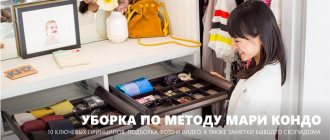The bestseller “The Magic of Tidying Up” included Marie Kondo in the list of The 100 Most Influential People, according to Time. According to the girl herself, he helped thousands of people around the world clear their homes of junk and change their habits. But not all of the advice from Japanese Marie is suitable for our country and mentality.
We'll go through Kondo's basic tips, break them down with examples, and adapt them so they really work for everyone.
Important: cleaning, as understood by the author of the book, is not wiping shelves and washing floors or windows. This is decluttering, getting rid of unnecessary and superfluous things that do nothing but collect dust and mold. This book will not save you from the need to maintain cleanliness.
What is this and where did this method come from?
First, a little history. The author of the method and the book, which has been translated into 40 languages, Marie Kondo was born in Tokyo in 1984. I have been obsessed with cleaning since childhood. This can be explained by her family's religious views. Shintoism believes that organizing space and cleaning are spiritual practices. In any case, when Marie is asked where her passion for order came from, she refers to religious beliefs.
At the age of 19, Marie Kondo founded a consulting company on space organization, which served as the origin of the Konmari system. Its main principle is to create an environment around you where every thing brings joy. If the thing you picked up does not awaken pleasant emotions in you, you need to get rid of it. The second principle is storage organization, but more on that below.
Documentation
According to Konmari, you need to throw away all documents except those that are frequently used - passport, insurance policy, documents for an apartment. The main candidates for disposal: newspaper clippings, postcards, utility bills, warranty cards.
All documents need to be sorted. Frequently used ones should be in the same folder. Utility bills must be kept for a year, warranty cards - as long as they are valid.
People often keep notebooks from university, but if a person does not put these notes into practice, then they have no meaning. And if he does, then he has already learned the information and does not need to keep notes.
The situation with cards is the same as with gifts. As soon as the person finished reading it, the postcard fulfilled its purpose - it showed the sender's attention. You should leave only those postcards that fill a person with joy when he reads them.
I had no problems with documents, as well as with books: everything even before Konmari was sorted into separate folders. I almost never receive utility bills because I signed up for email notifications. And those that arrive, I immediately pay online and don’t keep them at home.
Advantages of the Konmari system
- Allows you to restore order in the house once and for all. Marie Kondo believes that you need to devote one day to general cleaning, get rid of everything unnecessary and free up space, so that later you don’t waste time and effort on maintaining order.
- We learn to put things away in their places, which means we don’t waste time looking for them later.
- Things are organized in strict order, according to belongings - linen with linen, books with books, documents with documents.
- Any thing is easily accessible, you don’t have to dig through entire mountains to find it
- You see what and how much you have, everything is kept in order, and this will save you from spontaneous purchases.
Marie Kondo's book literally created a revolution, but in practice it turned out that this method is not suitable for everyone, and it is not free from shortcomings.
Magic cleaning. The Japanese art of putting things in order at home and in life. Marie Kondo.
Magic cleaning. The Japanese art of putting things in order at home and in life. Marie Kondo.
She was a strange child and instead of children's games she was engaged in... cleaning. In high school, her friends were looking for the perfect love, and she was looking for the perfect way to fold and store socks. Her parents thought she would make a good housewife, but she made millions helping people declutter their homes. Marie Kondo is the world's most sought-after tidying consultant and the author of the revolutionary KONMARI CLEANING METHOD. By following her recommendations, you will put things in order at home and in your life - once and for all.
On average, 45 large garbage bags are taken out by people cleaning a small apartment using Marie Kondo's method. Her book “Magic Cleaning. The Japanese art of putting things in order at home and in life” brought the 30-year-old woman worldwide fame. In 2015, Time magazine included Marie Kondo in its list of the 100 most influential people in the world. And all because of cleaning...
It seems strange, but only until you try to apply her method and put your house in order once and for the rest of your life. This book is for those who hate cleaning. With its help, you will get a home filled with only the things you need, and it will become a source of joy and strength for you. But most importantly, you will learn to listen to your heart and make life decisions that have an impact far beyond your closet.
Four reasons to read the book:
- believe that cleaning can be done once and for a lifetime;
- learn to understand your true desires;
- create a space around yourself full of joy and harmony;
- stop wasting what you need and buying what you don’t need. Forever.
10 main ideas of the book.
1. Real cleaning of one space is carried out only once in a lifetime. Once you put things in order, you will easily maintain it. If everything is done correctly, new waves of disorder will not threaten you.
2. Cleaning begins with selecting those things that make your heart happy. The remaining items must leave your home.
3. For the cleaning process to be effective, you need to clean by category: first, all items from the “Clothing” category, then - all books, all documents, all things from the “Miscellaneous” category, and finally - all sentimental items.
4. At the beginning of cleaning, all things from the category you are doing must be collected in one place.
5. To select, you need to pick up every item without exception and listen sensitively to your emotions.
If something makes you feel happy, like petting a puppy or kitten, it's yours. If you find it difficult to decide, are looking for rational arguments or justifications, you no longer need this thing. Don't worry about storage until you've finished sorting through all the items in that category.
6. Having finished selecting, carefully fold the remaining items into rectangles or rolls and store them in boxes.
7. Store clothes that feel better hung on hangers, placing them in groups from thick and dark to light and light.
8. Store everything possible vertically: clothes, papers, food containers. Don't buy fancy storage units—just regular shoe boxes for everything you need, which make great organizers.
9. Cleaning is a very personal process. Try to conduct it in such a way that no one can disturb you. Don't be afraid to throw away excess. Focus on your feelings and trust your intuition. Most likely, you will only have 25-30% of things left - but each of them will bring joy.
10. Real cleaning changes a person from the inside. He becomes calmer, more confident and decisive. This has a positive effect on all areas of life.
How tidying became a worldwide hit.
In December 2022, Netflix launched a new show... about cleaning.
Its heroine, the fragile Japanese Marie Kondo, became famous throughout the world for her book about how to properly clean up your home. This seemingly insignificant topic brought the 30-year-old woman worldwide fame.
The book, published in the USA in 2014, has been translated into 35 languages, and the total circulation of its publications has exceeded 2 million copies.
This seems strange, but only until you try to put into practice the method described in the book “The Magic of Tidying Up” (it has already been called the “KonMari Method”).
Some aspects of it seem radical or a little strange, but the author insists: just try it!
By following the simple principles of the KonMari method, you can clean your house once and for a lifetime. A house filled with only the necessary things, each of which has its own place, will become a source of joy and strength. The time spent on maintenance cleaning will be reduced significantly. But most importantly, you will learn to listen to your heart and make important life decisions, the impact of which extends far beyond the closet.
This book is for those who hate cleaning. For those who are tired of struggling with things. For those who consider themselves lazy and sloppy by nature. For those who spend too much time on putting things in order, which can be devoted to their favorite people and activities. For those who have forgotten how to hear the signals of their heart, are mired in painful relationships, suffer in a job they don’t like and want to finally sort out their life.
Magical cleaning using the KonMari method is your tool for finding inner harmony, strength and joy in life.
Marie Kondo's magic method.
None of us were taught how to clean. Every family has recipes and traditions passed down from generation to generation, but when it comes to cleaning, we are left to our own devices.
Marie Kondo was the middle child in the family, who was not really noticed by her parents, and spent a lot of time alone. From an early age, cleaning became her passion: the girl sought to harmonize the space, trying a variety of methods, throwing away and folding, arranging and organizing.
She went through a passion for beautiful organizers, numerous shelves and containers for everything in the world, through the desire to throw away everything unnecessary and protests from loved ones whose things became victims of her passion for order.
She tried every possible classification system and storage approach, tested one-zone-at-a-time and flow plans, followed the Japanese tradition of New Year's cleaning, and thought a lot about why clutter keeps coming back.
Finally, Marie Kondo has developed her own method - and now works with clients around the world and teaches how to clean once for a lifetime, and at the same time regain peace, joy and awareness.
By cleaning using the KonMari method, you change your thinking and clear space for what really matters to you.
Once you master the method, chaos and disorder will never return to your home and office.
Please keep this in mind as you apply the principles outlined in this book. You will have to work hard - but only once. The result will delight you for many years.
(Image of the future).
Before you open your closets, you should imagine the ideal image of your future.
• Visualize the space you want to live in. If you are experiencing difficulties, select beautiful pictures from magazines, visit interior salons and exhibitions.
• Formulate what kind of life you want for yourself.
List the activities you want to devote your time to in an updated, organized space.
Try to fill the image of the future with living, attractive details for you - those that will make you happier.
The picture of the future created at this stage will fill you with inspiration for magical cleaning.
One giant step
For cleaning to help change your mindset, it needs to be done in one go. Practice shows that this process can last up to six months - but it is important to complete it so that in subsequent years you can enjoy life surrounded by those objects that bring you joy.
Two stages of successful cleaning:
• first get rid of all the things that don't bring you joy; • then find a place for each item you decide to keep.
At the end of the cleaning, you will experience an incredible uplift, a feeling of freedom, joy and strength. This experience will become your protection against the return of chaos and clutter. There will be nothing unnecessary in your life anymore.
Once you experience the powerful impact of a perfectly organized space, you will never go back to clutter again.
Getting ready for the cleaning holiday.
Cleaning is a special event, an important turn in your destiny and the destiny of your things. Therefore, treat it like a holiday: dress in beautiful, comfortable clothes and completely immerse yourself in the process.
Focus is very important, so don't play music.
Give yourself privacy. Cleaning is an intimate matter. No one should see how you sort out your things and interfere with the process.
The best time to start cleaning is in the morning. So let's begin...
Cleaning by category.
As a rule, things related to each other are scattered throughout the home.
Cleaning each room separately means dooming yourself to the return of the mess. The right approach is to clean by category.
All things in the house can be divided into five categories:
• clothes, • books, • documents, • miscellaneous, • sentimental items.
You need to move in exactly this order: first, fully work out one category and only then take on another.
The order of the categories is also not accidental.
Practice shows that at first it is difficult for people to hear the signals that this or that object sends them.
And in order to decide whether to keep a thing or say goodbye to it, it is very important to learn to understand your feelings.
After all, the goal is to keep around you only those objects that fill you with joy.
By observing the order of the categories, you will gradually train yourself to hear your heart, save a lot of strength and gradually, step by step, create an ideal order.
Category one. Cloth
First step. Collect and divide.
First you need to collect all the things of one category in one place.
As a rule, at this stage people experience shock: mountains of clothes are piled up, completely covering the floor. Only now do you see how much stuff you actually have. It looks scary, but we know what to do.
Now you need to take each item in your hands and listen to your feelings.
When you pick up something that brings you joy, a very special feeling arises inside: as if you were petting a puppy or kitten.
This kind of thing needs to be put aside - you will save it.
If the heart is silent, then it’s time to say goodbye. Politely thank the item for its service to you and set it aside.
Some things are not given to us so that we can use them for their intended purpose. Sometimes their task is to teach us to choose correctly.
If there are too many clothes, divide this large category into subgroups:
• tops (everything from T-shirts to warm sweaters); • skirts and trousers; • clothes that need to be hung on hangers (suits, outerwear); • socks and stockings; • accessories; • shoes.
Within each category, it's easier to select out-of-season items first - you'll get into an optimistic mood by asking yourself the question, "Do I want to see this thing again?" and keeping those things about which you confidently answer “yes!”
Things like “no” or “I don’t know...” are worthy of you releasing them.
Completely deal with the non-seasonal items from one group, then with the seasonal ones - and only then move on to the next one.
You may feel like you're throwing away an awful lot of clothes, but if you choose items that make you happy, you'll end up with just the amount you need.
And please forget about the concept of “lounge clothes” - as a rule, things that are put aside to wear at home, then sit bored in drawers for years.
Time spent at home is a precious part of life.
You can and should wear at home not some “demoted” clothes, but only those things that bring you true joy.
Second step. Storage.
All the things that you have selected should have their permanent place in the house.
You'll put each item away after use, caring for it, giving it a chance to rest and serve you again - and, of course, maintaining order.
Do not hang things on hangers, but fold them into neat rectangles or rolls and store them in drawers, placing them on their edges.
• It saves space.
Folding allows you to fit 20 to 40 items of clothing in the same space it takes to hang 10 items.
• Things that are lovingly ironed and neatly folded are filled with energy, look better and last longer.
All new clothes, socks, stockings, etc. should be immediately unpacked, folded and hung along with other items in this group.
Things that have retained their labels and packaging become “invisible” to their owners and contribute to cluttering the space.
To fold clothes:
• lay it out on a flat surface, gently smooth it with your palms; • fold the front of the T-shirt or sweater towards the middle, place the sleeve on top of it, then do the same on the other side - you have a long and narrow rectangle; • fold the rectangle not exactly in half, leaving a small area at the neck free; • fold the resulting rectangle in three so that you get a neat envelope; • place the item on its edge: if you did everything correctly, it will remain vertical.
To roll jeans , first place one pant leg over the other, folding the waistband in half.
Then fold the jeans in half lengthwise, leaving a gap of about 5 cm wide at the top. Then fold it in thirds.
To fold socks , carefully straighten them, place one on top of the other, then fold them in half lengthwise and in half again to create a rectangle.
Underwear is folded according to the same principle , turning each pair of panties into a neat rectangle. Bras are stored straightened out, nested one inside the other and placed on the bottom of the drawer in a vertical position.
Stockings and tights are rolled in the style of Japanese rolls : first, smoothing and placing one stocking on top of the other, then folding it in half, leaving a narrow strip of the top free, and finally rolling it into a roll. These rolls are stored in the same way, placed vertically in a box.
There is an ideal folding shape for every item, and when you find it, you will immediately feel it. Check by placing the item on its edge.
Once you've folded your items, place them in your drawer, placing the lightest items in the front and the darkest items in the back.
Shoe boxes may be useful for underwear, tights and socks - they are convenient for storing rolls of small items.
Exceptions to the vertical storage rule are items that feel better when hung: clothes made from thin, flowy fabrics; designer clothing; suits, jackets and coats.
You will store them on hangers, dividing them into groups and hanging them according to the principle from thick to light and from dark to light.
Putting seasonal clothes away after decluttering is unnecessary.
You may want to stash swimsuits and summer hats for the winter, and scarves, hats and gloves for the summer. This is quite enough. Other clothing should be stored as usual.
Category two. Books.
When sorting books, use the same principles you apply to clothing. First, put all the books you have in one place, then pick up each of them and listen to your feelings.
The only criterion you should be guided by is the feeling of joy.
Don't get distracted by thinking about the usefulness of the book or the fact that you never read it. Books, no less than other things, want to be useful and bring joy - and if a given copy does not coincide with you emotionally, it is better to let it go.
With books, timing is everything. The moment when you come across a particular book is precisely the time when you need to read it. In order not to miss this moment, I recommend that you limit the size of your book collection.
The books you have already read have become part of your personality. The ones you never leafed through taught you how to make better choices. Those that you “really need” to read, but for some reason you can’t, are also better to thank and throw away: if you really need information on this topic, you will buy another copy and then you will definitely read it.
Category three. Documentation.
Throw away all documents except those that need to be kept forever.
Documents about property, education, certificates and others take up very little space when folded into vertical organizers.
Collect all warranty cards and put them in one transparent folder - by looking through it periodically, you can at the same time get rid of those whose expiration date has expired.
Leave letters from people dear to you, photographs and other similar items for now - this is the fifth category, and you will deal with it last.
Throw away the instructions for the equipment immediately - if the need arises, you can easily find them on the Internet.
Materials from courses and seminars are also thrown away : if you apply the acquired knowledge, you already know everything that is written in the handouts. If you don’t use it, it means you don’t need them and you’ll never re-read it.
Keep paid utility bills for a year.
Other bills, credit card statements, alerts and notices, as well as newspapers, magazines and other paper waste are subject to release.
Set aside a small space for documents that need to be sorted out (checking bills and letters) and put the rest in a trash bag.
Even the author of the book “Magic Tidying Up” has a folder with current documents that is never empty, but this is something to strive for.
Category four. Miscellaneous
The most extensive and diverse category, which includes:
• cosmetics; • accessories; • valuable items (passports, credit cards, etc.); • electrical instruments and devices; • equipment for housekeeping (stationery and writing materials, etc.); • household supplies (consumables: medicines, cleaning supplies, paper napkins, etc.); • kitchen goods and food supplies; • things for hobbies (ski equipment, equipment for handicrafts, etc.).
How to parse a heterogeneous category:
• gifts have already fulfilled their role: they showed you the love of the giver; today they are just things, and if they do not bring joy here and now, they need to be released;
• packaging from equipment should be thrown away if they are not suitable for storing small items, underwear or socks;
• store perfume bottles
Organize everything else into groups and store them together (all supplies with supplies, all kitchen utensils in one place; “paper”, “electric” and “made of fabric” - with each other), neatly laid out and arranged by size.
Places for storing things in this category should be chosen based on the principle of “easy to put away” and not “easy to get.”
When going to do something, a person usually does not mind getting the item he needs; but having finished the job, sometimes it’s not easy to force yourself to put the tool back in its place.
For standard-sized housing, there is no point in building complex route maps - it is enough to store all such things next to each other.
Storage should be extremely simple - and so that you can see at any time how many things you have. This will prevent you from hoarding.
It is enough to put away those things that are rarely used, and store the rest as described.
“When choosing what to keep, ask your heart; when choosing where to store, ask your home.”
Category five. Sentimental items.
Having honed your cleaning skills on less emotionally significant items, you are ready to sort through the last, fifth category. These are photographs, souvenirs, letters and memorabilia.
They also have to be divided into those that bring you joy today - and those that have already fulfilled their beneficial function and can go to rest.
“Truly precious memories will never be erased, even if you throw away the items associated with them. No matter how wonderful our past may be, we cannot live in it. Much more important is the joy and delight that we feel here and now.”
Keep only the most meaningful items that bring you joy.
Touch every object with your hands. Take photos out of albums. Keep only the best.
Thoughtfully sort through these sentimental items, rather than shoving them into one box that will be “kept forever” in the far corner.
Only by sorting out the objects of the past will you feel complete peace of mind and open the door to important positive changes in your life.
“The space we live in should be for the person we are becoming now, not the person we were in the past.”
Each family member should have a single place to store all personal belongings.
But even if your family doesn't rush into cleaning or doesn't do it as thoroughly as you'd like, you'll find that your irritation will decrease: when your personal space is organized and brings you joy, other people's mess bothers you less.
(Magic “click”).
Everyone has their own personal limit when the number of things becomes exactly as needed. This is the “click point” - the moment of realizing that the job is done and you can stop.
As long as you intuitively feel that you have not finished tidying up, continue to follow the rules described - and in the end you will feel that you have reached the maximum.
Cleaning using the KonMari method is an opportunity to make your home as personal as possible, because only those things that fill your heart with joy will remain in it.
You will see yourself as you really are. You will understand what you value, what is important to you. And the magical effect of this cleaning will affect all the decisions you make in the future.
You will have a different attitude towards shopping: impulsive shopping will become a thing of the past, only those items that truly make you happy will appear in your home.
And even “strategic reserves” will begin to decrease - because you will not only understand, but also feel how much easier and more pleasant it is to live in a house free of unnecessary things.
Figures from the practice of Marie Kondo:
90% of people fall into the “I can’t throw it away and don’t know how to put it back” category, 10% of people fall into the “I don’t know how to put it back” type.
On average, people take out 45 large garbage bags
25–30% of the original number of items usually remains with Marie Kondo’s clients after selection.
(Your ideal life).
Having worked hard, you have made your home the way you pictured it in your dreams. Now all you have to do is put things back in their place every day and maintain cleanliness.
If you have sorted everything completely, the junk will not return.
A light mess will be easy to clean up in a very short time. Keeping your premises clean will become much easier.
The author of the KonMari method, every day, returning from work, empties her purse and sends it to “rest”, and puts those items that she needs daily (wallet, travel card, lipstick and keys) in a box in the top drawer of the chest of drawers - this helps not to forget the necessary little things getting ready in the morning.
Following the Japanese tradition of treating things with such respect as if they had a soul, Marie Kondo thanks her things for the support they provide her every day - and is confident that this approach fills her life with joy, and helps things retain their beauty and beauty for a long time. functionality.
You can do this daily and out loud, or you can do it mentally and from time to time, especially if this practice bothers you at first. Gradually, you will begin to feel how the house responds to your greeting, and things rejoice at your gentle touches.
“Things that are treasured shine.”
The magic of cleaning
Once you finish cleaning your house using the KonMari method, you become a different person. Now you have more space and time in your life for what you really love. While sorting things out, you remembered what makes you most happy. Realize what motives and aspirations guide your actions. You understand what place in your life is occupied by thoughts about the past, and what place is occupied by fear of the future. You have looked into the face of your real self.
We learned to make important decisions based on the signals of your heart, and strengthened our self-confidence.
Chances are, like other Marie Kondo disciples, you felt more energetic, fit, and youthful after getting rid of unnecessary things.
Cleaning using the KonMari method has opened the door to a happier, more vibrant life. Congratulations!
Why do you need to do this?
The Konmari method is not about washing dishes and dusting. This is, first of all, a whole philosophy. Marie believes that the main goal in life is to achieve happiness, and we should do everything for this. Therefore, you need to surround yourself with joyful things, then your home will become a place of attraction where you want to constantly return. The cleaning procedure itself is designed to bring us closer to happiness. Achievable goals:
- There is harmony and beauty in the house.
- Space has freed up.
- There is more free time.
- I don't waste time looking for the right thing.
- I have achieved inner comfort.
This technique consists of two stages: getting rid of junk and organizing storage. Below is a little more detail about each of them.
Miscellaneous
People often keep things out of inertia, and not because they enjoy them. Therefore, the “miscellaneous” category should be divided into subcategories to make it easier to understand.
Subcategories could be:
- CD and DVD discs;
- cosmetics;
- accessories;
- electrical appliances and electronic devices;
- tools - screwdrivers, shovels;
- supplies - medicines, detergents;
- kitchen goods;
- other.
Subcategories also depend on what a person does. For example, a skier might have a subcategory called “equipment.”
Marie Kondo recommends collecting all the small change in your wallet, throwing away boxes from electrical appliances, not storing disposable items, spare buttons and strange cords: if a person cannot identify a wire, it is unlikely that he will ever need it. Perhaps this is charging from an old player that has long since broken down and was thrown away.
In the case of buttons, it is worth asking yourself the question: “When my button came off, did I sew on a spare one?” Most likely, the answer will be “no” - people either continue to wear the item without a button, or throw it away in the closet. Marie Kondo recommends sewing spare buttons to the lining of a jacket or coat, and in the case of other types of clothing, there is no need to store buttons - if you need them, you can easily buy them at the store.
Boxes from appliances should be thrown away simply because they take up space in the house. Sometimes people keep boxes in case they move, but the assumption that an item might be needed one day is not a reason to keep it.
People often keep samples and miniatures of cosmetics for travel, but these have a shelf life of several weeks to a year. Marie Kondo specifically clarified this issue with cosmetics manufacturers, and they explained to her that the less content, the faster its quality decreases. Plus, samples most often just lie in the closet and people forget to take them on a trip.
At first I thought that the biggest bags would be bags of clothes, but the “miscellaneous” category turned out to be the most cluttered
The photo shows only a small part of what I managed to find and what I decided to get rid of: laces, ropes and strange wires, a student cover, stickers, coffee cards from another city, old phone cases, a broken gamepad and power bank, a bottle of a skull that I was going to use as a vase, a coin from McDonald's, a stupid notebook that Ozone sent me as compensation for missed delivery deadlines. I kept all this for no apparent reason.
My biggest subcategory in the “miscellaneous” category is “cosmetics.” As with clothes, I've never collected all the items from one category in one place, so I was surprised when I arranged all the cosmetics from the bathroom, closet, bags and makeup cases on the table.
There were so many cosmetics that we had to create subcategories within a subcategory. I had these: decorative items, care, samples and miniatures, hair and body products.
Many products have already expired, so they had to be thrown away.
#4 - Consider how often you use things
The more often you use certain things, the closer they should be to you. Not in the literal sense of the word, but in terms of accessibility. Then it’s better to put them where they can be easily reached. And those items that are rarely used can be put away in hard-to-reach places - for example, in the back of a closet or on a high shelf.
#3 – Separate items by size
Sorting things according to the “like with like” principle is not always correct. Sometimes it's worth sorting them by size. This is the case when we are talking about things with the same frequency of use. Such items can be stacked next to each other, focusing on their size. That is, for example, put all the small things in one box, and all the medium ones in another. This method will help you remember where things are stored when necessary.
#7 – Place things vertically
If you have very little space in your closets, then do not stack things in piles as you are used to. It is better to use a vertical method of storing them. Firstly, it’s easier to organize things this way. Secondly, it’s easier to get the options you need without disturbing the order of the others. Thirdly, you immediately see where the item you need right now is. What’s interesting: things stored vertically last longer and deteriorate less, which means they last much longer.
#8 – Don’t forget to be grateful
Skeptics should skip this advice. Remember that you should always clean with a pure heart and gratitude. Even those things that have now turned into trash were once new and very necessary for you. They just served their purpose. And before you throw them away, thank them for their work. And the house itself is worth thanking for the roof over your head and comfort. In this case, you can significantly improve the mental atmosphere in your home and attract positive energy into it.
Special clothing
Every wardrobe has clothes for special occasions. We are not talking about special events and holidays at all. Tourism, sports and many other activities require a special “uniform”. Some people prefer to have a separate set for working in the garden or home workshop. Marie advises storing such things by categories. Namely: each set for a specific activity should be on its own shelf. If your special clothing is seasonal - let's say it's a ski suit - it can be put away on the far shelf of the closet, having first been protected from dust with a clothing cover. Ms. Kondo also includes “special” items that you wear at home and when you sleep. For home and night clothes, it is appropriate to allocate a whole drawer or shelf.
Only transparent containers are used for storage
If you want (need) to buy containers, you should choose transparent ones. These are baskets made of rattan, metal, plastic. They are transparent, which makes it impossible to forget something.
Sentimental
Sentimental items are the hardest to sort through - they remind you of how happy a person was. But such an analysis helps to understand the past.
Marie Kondo notes that people are often afraid of losing memories, but truly important moments, according to the author, will never be forgotten. You need to value not memories, but the personality that a person has become or is becoming. Therefore, you need to store not a hundred photos from your trip, but choose five to ten of the most important ones. Photos should be immediately sorted into albums, and not just put in one place.
Parents often keep mementos from their children—drawings, crafts—and are afraid that if they throw them away, they will hurt the child’s feelings. Kondo is sure that this is not the case. Most likely, the grown children will only be surprised that their mother still keeps all these things.
The breeding ground for sentimental items in my home is my workspace.
After I dismantled the workspace using the Konmari method, some of the photographs, leaflets and postcards disappeared from the board, and there was free space for notes.
Magic origami from your clothes
When storing clothes, Marie Kondo suggests following a simple principle: fold and place vertically everything that can be folded. Simple small items of clothing - for example, stockings and scarves - can be folded into neat rolls along the height of the drawer (in one or two folds of the item). Folding things according to Marie Kondo's method is a real art, but anyone can successfully master it if they want. The author of this unique technique recommends folding complex-shaped wardrobe items - T-shirts, sweaters, trousers - into an even rectangle. In this case, you should focus on the shape and size of the item. Marie suggests first folding a standard T-shirt along the long side three times, folding the edges of the product twice towards the middle. The resulting long rectangle is folded several times in the same length until the optimal size is obtained. M. Kondo claims that things folded correctly according to this principle do not wrinkle at all during storage. It’s easy to check whether you folded the T-shirt correctly: the resulting rectangle should stand confidently without support.
#10 – Pack things properly
Marie advises not just putting things in cabinets and boxes, but folding them in a certain way. For example, it is better to give each item of clothing the shape of a tight rectangle. And it is best to arrange them by color in transparent containers, from light at the beginning to dark at the end. This way, the shelves in your closets will look beautiful and neat, and it will be easier for you to find the thing you need.
Things on hangers also need to be hung according to the system - from long to short. Or by color - the same ones next to each other. Or from heavy to light fabrics. In short, choose one method or another and implement it. Your cabinets will be transformed beyond recognition.











